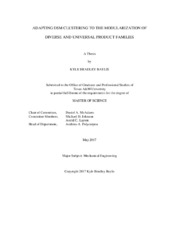| dc.contributor.advisor | McAdams, Daniel A | |
| dc.creator | Baylis, Kyle Bradley | |
| dc.date.accessioned | 2017-08-21T14:43:53Z | |
| dc.date.available | 2019-05-01T06:10:25Z | |
| dc.date.created | 2017-05 | |
| dc.date.issued | 2017-05-08 | |
| dc.date.submitted | May 2017 | |
| dc.identifier.uri | https://hdl.handle.net/1969.1/161602 | |
| dc.description.abstract | Product family design is a popular approach for designing a group of related products to strategically share common features and components. One method for developing product families is by using a combination of shared and unique modules. The success of a modular product family largely depends on the proper selection of modules and module boundaries. While a number of methods exist for the modularization of individual products, many of these methods are not currently suited for use with product families. The objective of this research is to develop a method for extending the use of popular component-based modularization methods to product families. This thesis primarily consists of two distinct manuscripts.
In the first manuscript, a method for extending the use of DSM clustering to the modularization of diverse product families is presented. In this approach, the modular architecture of the product family is optimized while also maximizing commonality between products. A Pareto front is developed of different architectures that produce optimal strategic modularity and maximized commonality in the product family. The proposed method is applied in a case study to the design of a product family of power tools. In this case study, the quality of the modular architecture is evaluated using a DSM (Design Structure Matrix) for each product. Three architectures along the Pareto front are chosen and examined to demonstrate the usefulness of the technique.
The second manuscript presents an approach that incorporates the use of the proposed modularization method in the design of universal product families. The approach utilizes market segmentation techniques and action-function modeling to identify the special design requirements for disabled users. An algorithmic approach is employed to generate modular architecture alternatives for constructing the detailed product family. The approach is demonstrated using a case study over the design of typical and inclusive vehicle driver seats. | en |
| dc.format.mimetype | application/pdf | |
| dc.language.iso | en | |
| dc.subject | product design | en |
| dc.subject | product family design | en |
| dc.subject | modular design | en |
| dc.subject | commonality | en |
| dc.subject | modularity | en |
| dc.title | Adapting DSM Clustering to the Modularization of Diverse and Universal Product Families | en |
| dc.type | Thesis | en |
| thesis.degree.department | Mechanical Engineering | en |
| thesis.degree.discipline | Mechanical Engineering | en |
| thesis.degree.grantor | Texas A & M University | en |
| thesis.degree.name | Master of Science | en |
| thesis.degree.level | Masters | en |
| dc.contributor.committeeMember | Johnson, Michael D | |
| dc.contributor.committeeMember | Layton, Astrid C | |
| dc.type.material | text | en |
| dc.date.updated | 2017-08-21T14:43:53Z | |
| local.embargo.terms | 2019-05-01 | |
| local.etdauthor.orcid | 0000-0002-5521-5506 | |


